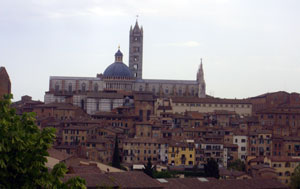Greetings All,
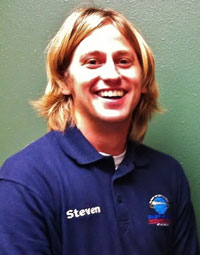 Before I get started about my travels to Siena, Italy and my experiences, I have one order of business to take care of. My previous entry mentioned Steven Bohlemann, a student who works in the Study Abroad Office, but I was not able to get a picture of him in time before I turned the journal admission. As promised, here is a picture of Steven (courtesy of the Study Abroad Office in Daytona Beach).
Before I get started about my travels to Siena, Italy and my experiences, I have one order of business to take care of. My previous entry mentioned Steven Bohlemann, a student who works in the Study Abroad Office, but I was not able to get a picture of him in time before I turned the journal admission. As promised, here is a picture of Steven (courtesy of the Study Abroad Office in Daytona Beach).
During my travel to Siena, Italy, I had layovers in Houston, Texas; Amsterdam, Netherlands; and Rome, Italy. I found flying was the least stressful mode of transportation I experienced. My travel was fairly simple because I did not have to worry about carrying my luggage around and that my ticket told me, in English, directly where to go. However, when I traveled by train I was very tense because I had to constantly watch my luggage at the crowded train station and keep an eye out for the correct train.
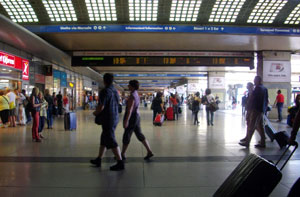 The most nerve wracking event I experienced was when my train was fifteen minutes late. When this occurs, passengers neither know when exactly their train will arrive, nor do they know the platform, or binario, where their train will be located. To make matters worse, I only had a fifteen minute layover between trains in Chiusi Chianciano. Luckily, my delay did not cause me to miss my second train to Siena. After I arrived at the train station, I took a taxi cab to the Residenza San Domenico, the place where students are housed.
The most nerve wracking event I experienced was when my train was fifteen minutes late. When this occurs, passengers neither know when exactly their train will arrive, nor do they know the platform, or binario, where their train will be located. To make matters worse, I only had a fifteen minute layover between trains in Chiusi Chianciano. Luckily, my delay did not cause me to miss my second train to Siena. After I arrived at the train station, I took a taxi cab to the Residenza San Domenico, the place where students are housed.
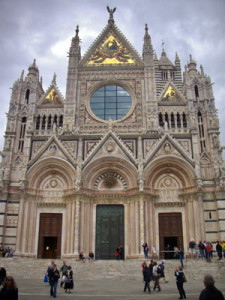 The rooms at Residenza San Domenico are decently furnished. Rooms can house anywhere from two to four students depending on the room. My roommate is a girl from Prescott, Daytona’s sister campus, named Candace. We get along great. No two rooms are alike, but each has a bathroom with a large wardrobe that contains a small kitchenette unit that houses a large sink and hotplate. In addition, silverware, dishes, and cups are provided with the rooms. Some rooms have lofts and others will have large closets and drawers. One of the rooms meant for students has a phenomenal view of neighborhoods across the valley as well as the Duomo, a large gothic church located on of the other hills of Siena.
The rooms at Residenza San Domenico are decently furnished. Rooms can house anywhere from two to four students depending on the room. My roommate is a girl from Prescott, Daytona’s sister campus, named Candace. We get along great. No two rooms are alike, but each has a bathroom with a large wardrobe that contains a small kitchenette unit that houses a large sink and hotplate. In addition, silverware, dishes, and cups are provided with the rooms. Some rooms have lofts and others will have large closets and drawers. One of the rooms meant for students has a phenomenal view of neighborhoods across the valley as well as the Duomo, a large gothic church located on of the other hills of Siena.
When the Duomo was constructed the thirteenth century, the Sienese wanted to make sure that the world knew that the people of Siena built the church, not the pope. As a result, the entire building displays the link between the Duomo and Siena. Outside of the main entrance, there are two pillars with statues on top of a female wolf nursing two small children. The she-wolf with the two children, Romulus and Remus, is the symbol of Siena and shows the city’s strong connection to ancient Rome.
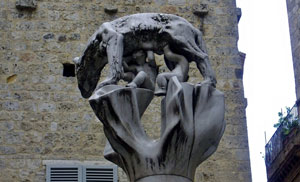 According to the legend, Romulus, the found of Rome, had two sons, Senius and Aschius. It was these two men who founded Siena. Their colors, white and black, are displayed on the flag of the city and in the colors of the Duomo. On one side, there is an outcropping of red brick and a black and white marble wall. According to my professors, the church was supposed to be much larger than it is today. Work on the expansion halted when Siena was struck by the bubonic plague, which killed about two thirds of the population. I walk by the Duomo every day on the way to class.
According to the legend, Romulus, the found of Rome, had two sons, Senius and Aschius. It was these two men who founded Siena. Their colors, white and black, are displayed on the flag of the city and in the colors of the Duomo. On one side, there is an outcropping of red brick and a black and white marble wall. According to my professors, the church was supposed to be much larger than it is today. Work on the expansion halted when Siena was struck by the bubonic plague, which killed about two thirds of the population. I walk by the Duomo every day on the way to class.
My school day typically consists of taking two classes. One class is run by Dante Alighieri. The college is named after the famous Italian writer and is focused on promoting Italian language and culture. It is located in the tartuca, or tortoise, contrada.
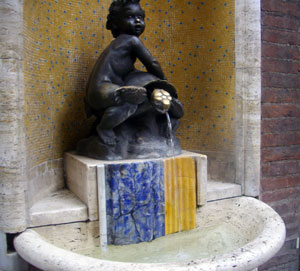 The other class is run by Embry-Riddle. At 9 AM, I take an Italian language class with Massimiliano, an Italian professor. Our learning consists of using a text and workbook along with supplementary lessors. We have learned a lot so far. Typically we have a short 30 minute break at 11AM. This is when most students eat lunch. At 11:30, we either have Massimiliano again or we study Italian culture under Dr. Luca Bonomi, the director of Dante Alighieri. When we have Luca, we usually have a short presentation in class and then he takes us outdoors to walk around and explore Siena. We have visited the Piazza del Campo, which is the city center, as well as the main political buildings. One day, we even analyzed Italian body language and what each of the subtle nuances mean. It was fascinating. After either another session with Massimiliano or Luca, we get another short break of about 15 minutes or so at 1:30 PM. Then we are taught by ERAU professors Dr. Alan Pratt or Dr. Robert Fleck. Dr. Pratt teaches art history, which occurs during the first two weeks of our session. He tries very hard to make sure that we are getting the most out of our studies with daily quizzes that require one word answer and consists of about 15 questions. After Dr. Pratt leaves, we study under Dr. Fleck who teaches Italian contributions to both art and science. Professor Fleck is a high energy teacher. It is quite evident that he is passionate about science. One day, he even tried to draw the solar system on the classroom floor while jumping about in an Einstein t-shirt. He is very entertaining. The end of our day can occur as early as 2:30 PM and as late as 4 PM. It just depends on the day. Luckily, we get three day weekends.
The other class is run by Embry-Riddle. At 9 AM, I take an Italian language class with Massimiliano, an Italian professor. Our learning consists of using a text and workbook along with supplementary lessors. We have learned a lot so far. Typically we have a short 30 minute break at 11AM. This is when most students eat lunch. At 11:30, we either have Massimiliano again or we study Italian culture under Dr. Luca Bonomi, the director of Dante Alighieri. When we have Luca, we usually have a short presentation in class and then he takes us outdoors to walk around and explore Siena. We have visited the Piazza del Campo, which is the city center, as well as the main political buildings. One day, we even analyzed Italian body language and what each of the subtle nuances mean. It was fascinating. After either another session with Massimiliano or Luca, we get another short break of about 15 minutes or so at 1:30 PM. Then we are taught by ERAU professors Dr. Alan Pratt or Dr. Robert Fleck. Dr. Pratt teaches art history, which occurs during the first two weeks of our session. He tries very hard to make sure that we are getting the most out of our studies with daily quizzes that require one word answer and consists of about 15 questions. After Dr. Pratt leaves, we study under Dr. Fleck who teaches Italian contributions to both art and science. Professor Fleck is a high energy teacher. It is quite evident that he is passionate about science. One day, he even tried to draw the solar system on the classroom floor while jumping about in an Einstein t-shirt. He is very entertaining. The end of our day can occur as early as 2:30 PM and as late as 4 PM. It just depends on the day. Luckily, we get three day weekends.
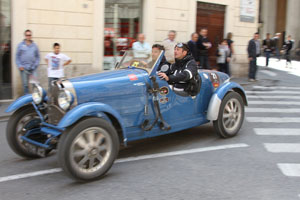 During my first weekend in Siena, while I was walking around with my friend Nathan, I saw an old car race.
During my first weekend in Siena, while I was walking around with my friend Nathan, I saw an old car race.
Picture of an old blue car that we saw racing, taken by Nathan Grand
These cars were going about 40 miles an hour throughout the city of Siena. Spectators could feel the vibrations of the ancient engines in their chests. When going around corners, they would warn everybody by honking their horns, which made the classic arrooga arrooga sound! Entire families were waving flags while the children cheered incessantly. It was truly a sight to behold. That same day, Nathan and I walked around and explored Siena.
The following pictures were taken around the city, both inside and outside of the old city walls.
The old part of the city of Siena is located within the medieval walls. The above picture displays what the Duomo looks like from afar. In addition, it shows the height and proximity of the buildings as well as that the city is built on hills.
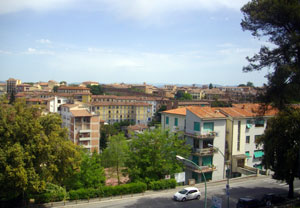
The younger parts of Siena feature wider streets and more sunlight that reaches the ground.
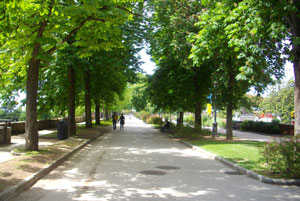
Among our explorations, Nathan and I found where all of the locals go to exercise and play. About a five minute walk from our residence, we came across an old fort. The Italians treat the fort much like a park. There are plenty of people running and exercising, in addition to just hangout out on the low walls and benches. We even saw a father teaching his son how to play soccer.
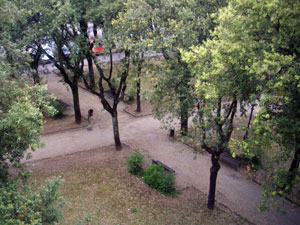
Below the fort, to one side, is located a beautiful and very peaceful park. Citizens walk through this area on the way to the small market that takes place on Wednesdays and Sundays. Vendors at this market sell cheap clothing, food, crafts, and sometimes animals.
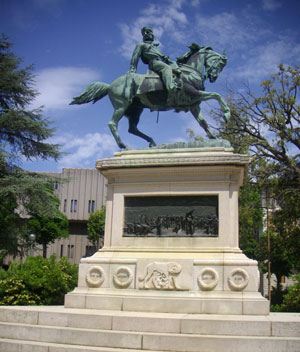
Notice that in the base of this statue contains the symbol of Siena: the she-wolf with the two children. This concluded my first week in Siena, Italy.


